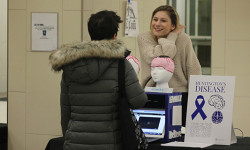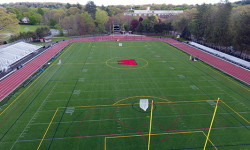[ccfic caption-text format="plaintext"]
By Rama K Ramaswamy
The second Annual CreateAthon, a Wellesley Education Foundation event, was held at the end of March at Wellesley High School. The event was free due to generous sponsorship.
At the CreateAthon, high school and middle school students who live or go to school in Wellesley were tasked to work in teams to create an app from scratch. These apps were designed to target specific community problems such as environmental, educational, or health issues presented in problem statements by community members such as Wellesley Superintendent David Lussier, leaders from Sustainable Wellesley, and local business owners.
Wellesley High School Computer Science and Computer Club students, mentored by Dr. Robert Cohen, organized the program for the day to include four instructional workshops wherein all student teams were paired with mentors to allow all participants to learn the process of ideation and MIT App Inventor. This meant that no prior programming experience was required, "making the CreateAthon a great way for any student to explore how technology can leverage their interest in solving town and community problems", said WEF board member Katey Goehringer.
WEF-CreateAthon leadership members also include Beth Willett, Melissa Johannes and Anne Marie Cronin.
According to CreateAthon Student Chair Eleanor Boyd, she and her fellow organizers made the day "fun for students" by "making the day about teamwork.” Students worked with friends and created apps via collaboration, were asked to be creative and think outside of the box, and “were kept engaged through fun and interactive workshops which ensured each student participated.” furthermore, each middle school student was paired up with a high schooler to learn from them through team-oriented mentorship.
Computer programing for the day included two components. The morning featured four different workshops to learn the skills needed to formulate an idea to create a resultant app, and the afternoon presented the opportunity to build the app and present it. The four morning workshops focused on the concept of ideation, paper prototyping, and layout and coding in MIT App Inventor. The ideation and paper prototyping workshops were taught by professionals from Quickbase, a Cambridge company focusing on app building. After lunch, students divided into pre-set teams of four to work with their team mentor to create a poster for their business idea and their app. According to Goehringer, "the final hour of CreateAthon was earmarked for presentation time when students shared their apps with peers, parents and learned from/about what other teams created.”
According to Boyd, the high school planning and organizing team owes its success to the students. "Benjamin Lussier ran registration and our problem statement videos, Megan Krueger and Taylor McClennen coordinated the volunteers, Calvin Isley spearheaded the workshops, Luis Hoderlein solicited donations which allowed our event to be free to all participants, Henry Boyd organized the technology piece and Nasim Sheikhi was in charge of marketing and media outreach,” explained Boyd. “And Nasim will be taking over my role as chair next year when I graduate. I attribute a lot of the amazing work on this event to all these people who helped. These people are all involved in the computer science department at school in a variety of ways. Some are in CS class and the other people are in the CS clubs.”
Boyd thanked WEF on behalf of herself and her CreateAthon team, and explained the goals of the event in her own words.
“Since this was only the second year of the event, I think our main focus was to create a really strong community event and get a larger amount of the town and community involved,” said Boyd. “We also wanted to generally get more students involved in the computer science department. It is a field that is in demand for people, but also one that encompasses and is now part of so many industries.
“Computer science allows students to expand and explore their other interests, which is something we wanted to showcase at the CreateAthon. If a student was interested in conservationism and helping the environment, we welcomed these additional interests and allowed each team to focus their app on something they loved. The CreateAthon then allows students to understand the role of computer science in the expanding presence of technology in our world, while also illustrating how each of these students could enjoy programming.
“Hopefully students enjoy the event and it can serve as motivation to explore this field in the high school, boosting enrollment in both numbers but also diversity as people from different background and interests decide to pursue this field. I think this goal was reached. I saw so many students and teams attack problems they were personally passionate about. The volunteers from Quickbase who lead our ideation workshop always remark on the ease at which the teams can come up with tons of app ideas and problems they want to address. I think the secondary goal of then getting these students to continue to explore and engage in computer science will take a few years to come to fruition. Most of our participants are middle school students, so it will take a year or more for them to arrive at the high school and be ready to take the computer science classes here.”
In summary, in addition to praise for the 2018 CreateAthon from WEF Co-Presidents Erica Recht and Susan Ryan, the measurable impact of CreateAthon 2018 that dovetails with the WEF's mission included 77 participants, 18 teams, 53 percent females, 47 percent males, 35 percent 6th graders, 43 percent 7th graders, 16 percent 8th graders, and 16 percent high schoolers. New participants accounted for 75 percent of attendees, while 25 percent participated last year. 42 percent had no previous computer programming experience.
To view WEF CreateAthon 2018 courtesy of Wellesley Media, visit https://youtu.be/U-m28sABH8Y.





















